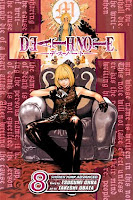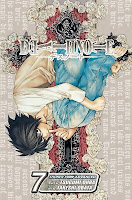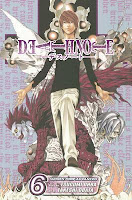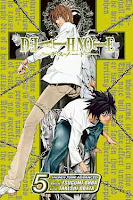 Author: Tsugumi Ohba
Author: Tsugumi Ohba
Illustrator: Takeshi Obata
U.S. publisher: Viz Media
ISBN: 9781421506296
Released: November 2006
Original run: 2003-2006 (Weekly Shōnen Jump)
Although I have been enjoying Tsugumi Ohba and Takeshi Obata’s popular Death Note manga series, I was mostly disappointed in Zero, the seventh volume. Still, there was plenty of good stuff going on and I definitely wanted to finish the series. I was looking forward to seeing where Ohba would take the story in volume eight, Target, especially considering the major plot developments that occurred in the previous book. Target collects chapters sixty-two to seventy of Death Note and picks up immediately where Zero leaves off. There are four more volumes after Target, five if you count the readers’ guide, but Death Note hasn’t shown any signs of slowing down yet. The series is in a very different place than when it first started, which is to be expected, but I still find the books to be engaging.
Four years have passed since the death of L. Light is now able to pose as his deceased opponent, making his secret identity as Kira even easier to maintain while serving as a primary investigator on the case. Public opinion has begun to favor Kira and Light has grown complacent in his relatively secure position. But L’s intellectual heirs have joined the game and Light will once again have to do some quick thinking. Mello has kidnapped his sister and is demanding the Death Note held by the Japanese police be turned over to him in exchange for her life. Light reluctantly join forces with Mello’s rival Near while striving to keep his multiple identities hidden. Near and Mello are both after Kira and the notebook, although for very different reasons, and Light will have to do all that he can to maintain his quickly dwindling advantages. And just as it looks like he might be in the clear, interference from the Shinigami realm changes everything.
Near and Mello make for interesting characters, but I’ll just come out and say it—I really miss L. The interaction between him and Light was fantastic and without L around to keep him on his toes Light seems to have lost some of his spark. Both Mello and Near come across as being rather young and I find their leadership roles and the amount of responsibility given to them hard to believe even considering their brilliance. The two of them will present Light with some decent challenges, especially since Light appears to be out of practice and Mello is more than willing to be ruthless in his methods to get what he wants. Although neither Mello nor Near are yet on par with L in regards to their intelligence, their general strangeness certainly is. Even with L gone, the conflicts between Near, Mello, and Light should prove to be interesting as they all try to outwit one another.
For the most part, Target hits on the major plot points from the previous books fairly well, but the series has progressed far enough now that it would be difficult for a new reader to jump in without being confused by some of what is going on. Death Note can be a bit text heavy at times since much of the story’s tension comes from characters’ internal dialogues as they try to out-think one another rather than from dramatic action sequences (although there are some of those, too.) However, readers are nicely led through the sometimes convoluted thought processes and Obata’s strong and consistent artworks greatly supports the story. I still prefer the series’ earlier volumes, but Target has helped regain some of the confidence I lost in Death Note while reading Zero. I’m not entirely sure where Ohba and Obata are heading, but I look forward to finding out in the ninth volume, Contact.




